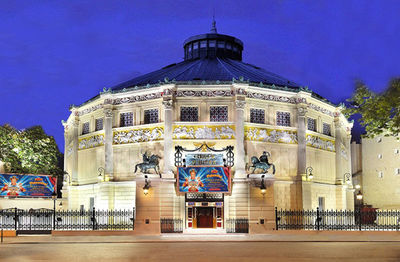Difference between revisions of "Main Page"
From Circopedia
| Line 16: | Line 16: | ||
[[File:Cirque_d'Hiver_-_Front_View_(2013).jpg|right|400px]] | [[File:Cirque_d'Hiver_-_Front_View_(2013).jpg|right|400px]] | ||
| − | === | + | ===ARNE ARNARDO=== |
| − | + | With his bushy sideburns, his Stetson hat, and his jovial personality, Arne Arnardo (1912-1995) was a legendary figure in his native Norway—where he was known as The Circus King—and in the European circus community. He had created Cirkus Arnardo in 1949; it became Norway’s largest and best-known circus, and remained so until the late 1970s, when Knut Dahl’s new Cirkus Merano slowly rose to a dominant position in that country. Yet Cirkus Arnardo never lost its reputation and is still recognized today (2015) as Norway’s premier circus. | |
| − | |||
| − | + | Arne Arnardo was born Arne Otto Lorang Andersen on October 12, 1912 in Sarpsborg, on the southeastern tip of Norway, the son of Einar (1888-1967) and Elna (1895-1920) Andersen. His father was a lumberjack. At a very early age, Arne showed an interest in show business; he is said to have given his first performance at age six—a puppet show that he presented in his parents’ home. | |
| − | + | He was fourteen when, in 1926, he "ran away and joined the circus": He found a job as a stable boy with Hartvig "Leonardi" Berg’s [[Cirkus Empress]], which had just visited Frederikshald (today Halden), not far from Sarpsborg. Although Arne was now in an environment that suited him better than the world of lumberjacks, he was not yet satisfied: His primary ambition was to perform. He trained as a contortionist and wirewalker, and made his debut in the ring in 1929 under the name of ''Armido''. Soon he changed it to ''Arnardo'', which he thought sounded better.... ([[Arne Arnardo|more...]]) | |
==New Biographies== | ==New Biographies== | ||
Revision as of 00:10, 1 August 2020
|
In The Spotlight
ARNE ARNARDO
With his bushy sideburns, his Stetson hat, and his jovial personality, Arne Arnardo (1912-1995) was a legendary figure in his native Norway—where he was known as The Circus King—and in the European circus community. He had created Cirkus Arnardo in 1949; it became Norway’s largest and best-known circus, and remained so until the late 1970s, when Knut Dahl’s new Cirkus Merano slowly rose to a dominant position in that country. Yet Cirkus Arnardo never lost its reputation and is still recognized today (2015) as Norway’s premier circus.
Arne Arnardo was born Arne Otto Lorang Andersen on October 12, 1912 in Sarpsborg, on the southeastern tip of Norway, the son of Einar (1888-1967) and Elna (1895-1920) Andersen. His father was a lumberjack. At a very early age, Arne showed an interest in show business; he is said to have given his first performance at age six—a puppet show that he presented in his parents’ home.
He was fourteen when, in 1926, he "ran away and joined the circus": He found a job as a stable boy with Hartvig "Leonardi" Berg’s Cirkus Empress, which had just visited Frederikshald (today Halden), not far from Sarpsborg. Although Arne was now in an environment that suited him better than the world of lumberjacks, he was not yet satisfied: His primary ambition was to perform. He trained as a contortionist and wirewalker, and made his debut in the ring in 1929 under the name of Armido. Soon he changed it to Arnardo, which he thought sounded better.... (more...)
New Biographies
- Tamerlan Nugzarov, Cossack Rider
- Circus Krone, History
- Nell Gifford, Circus Owner
- William Vos, Animal Trainer
- Jürg Jenny, Animal Trainer
New Videos
- Françoise Rochais, Juggling Act (2020)
- John Cox, Tiger Act (1988)
- The Bingo Boys, Acrobats (2020)
- Luis & Martha Palacio, Mixed Animal Act (1989)
- The Rasshivkin Family, Hand-to-Hand Balancing (c.1980)
New Oral Histories
- Vladimir Durov Documentary on Russian Television (c.2000)
- Dolly Jacobs Interview at The Ringling (2018)
- Pinito del Oro's Interview on Spanish Television (1970)
- Gia Eradze's Interview on SSU TV (2015)
- Rosa Bouglione's interview on Franch Television (2012)
Circopedia Books
- Philip Astley & The Horsemen who invented the Circus, by Dominique Jando (2018)
A Message from the Editor
CIRCOPEDIA is a constantly evolving and expanding archive of the international circus. New videos, biographies, essays, and documents are added to the site on a weekly—and sometimes daily—basis. Keep visiting us: even if today you don't find what you're looking for, it may well be here tomorrow! And if you are a serious circus scholar and spot a factual or historical inaccuracy, do not hesitate to contact us: we will definitely consider your remarks and suggestions.
- Dominique Jando
- Founder and Curator
